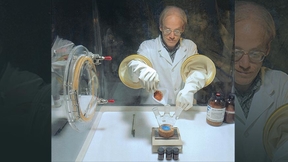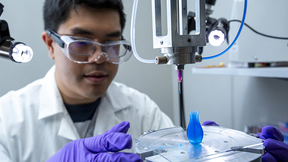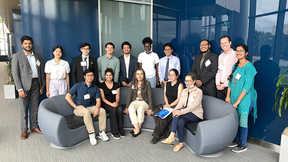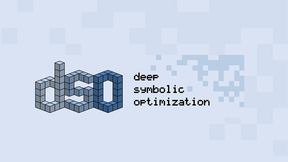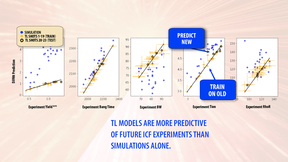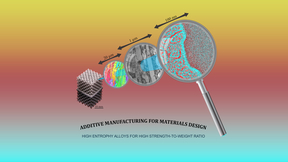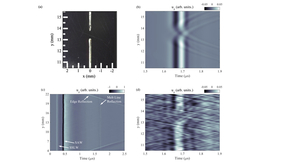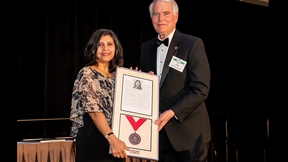Back
Engineering
Scientific discovery for stockpile stewardship
Scientific discovery during the Stockpile Stewardship Program maintains confidence in the nuclear deterrent without testing, brings other benefits The last nuclear test, code-named Divider, took place 30 years ago, on September 23, 1992. That year, President Bush declared a temporary moratorium on nuclear testing, which became permanent during the Clinton administration…
Developing technology to keep the nuclear stockpile safe, secure and reliable
The last nuclear test, code-named Divider, took place 30 years ago, on Sept. 23, 1992. That year, President Bush declared a temporary moratorium on nuclear testing, which became permanent in 1995, during the Clinton administration. This ending of the era of nuclear testing coincided with a Presidential announcement of the beginning of stockpile stewardship. As the decision…
Livermore researchers collect three awards among the top 100 industrial inventions
Lawrence Livermore National Laboratory (LLNL) scientists and engineers have garnered three awards among the top 100 industrial inventions worldwide. The trade journal R&D World Magazine recently announced the winners of the awards, often called the “Oscars of invention,” recognizing new commercial products, technologies and materials that are available for sale or…
Manufacturing Day webinar to highlight HPC’s impact on climate change, energy efficiency
The High Performance Computing for Energy Innovation (HPC4EI) initiative will hold a special webinar on Oct. 7 to celebrate Manufacturing Day and provide a forum for industry experts and Department of Energy (DOE) scientists to discuss how HPC can help combat climate change and improve energy efficiency. The virtual event begins at 8 a.m. PDT and brings together panelists…
Apprentice program graduates look forward to careers as Lab machinists
After earning a bachelor’s degree in health education at San Francisco State University, Kwadwo Kumi-Amankwah wanted a more hands-on career, so he took machining classes at Laney College and then applied to Lawrence Livermore National Laboratory’s Machinist Apprentice Program. That process began a four-year journey that concluded on Aug. 18, where he and three fellow…
LLNL and Case Western Reserve University to continue collaboration
The leaders of Case Western Reserve University and Lawrence Livermore National Laboratory (LLNL) signed a memorandum of understanding (MOU) to accelerate their efforts in shared areas of excellence. After three years of growing institutional collaboration in such areas as energy, materials science and polymer processing, Case Western Reserve President Eric W. Kaler…
LLNL team claims top AI award at international symbolic regression competition
A Lawrence Livermore National Laboratory (LLNL) team claimed a top prize at an inaugural international symbolic regression competition for an artificial intelligence (AI) framework they developed capable of explaining and interpreting real-life COVID-19 data. Hosted by the open source SRBench project at the 2022 Genetic and Evolutionary Computation Conference (GECCO), the…
Lab researchers win top award for machine learning-based approach to ICF experiments
The IEEE Nuclear and Plasma Sciences Society (NPSS) announced a Lawrence Livermore National Laboratory (LLNL) team as the winner of its 2022 Transactions on Plasma Science (TPS) Best Paper Award for their work applying machine learning to inertial confinement fusion (ICF) experiments. In the paper, lead author Kelli Humbird and co-authors propose a novel technique for…
New class of 3D-printed alloys brings more flexibility to super-strong metal parts
Metal 3D printing is used to produce components for many commercial applications, particularly in the transportation sector, where printing methods such as laser powder bed fusion (L-PBF) can produce super-strong and ultralight complex-shaped components that cannot be manufactured with conventional techniques. But while laser-based methods enable the manufacturing of…
Research finds mechanically driven chemistry accelerates reactions in explosives
Scientists at the Lawrence Livermore National Laboratory (LLNL) Energetic Materials Center and Purdue University Materials Engineering Department used simulations performed on the LLNL supercomputer Quartz to uncover a general mechanism that accelerates chemistry in detonating explosives critical to managing the nation’s nuclear stockpile. Their research is featured in the…
DOE announces new funding for High Performance Computing for Energy Innovation projects
The U.S. Department of Energy (DOE) today announced the latest funding round for the High Performance Computing for Energy Innovation (HPC4EI) initiative, awarding $3 million for 10 projects applying DOE supercomputing to advance clean energy technologies and improve manufacturing efficiency. HPC4EI is the umbrella initiative for the HPC4Manufacturing (HPC4Mfg) and…
LLNL researchers chart progress in architected materials that respond to external stimuli
Recent advances in pre-programmed architected materials could enable new functions that can evolve in response to their environments or external stimuli, according to Lawrence Livermore National Laboratory (LLNL) researchers. In a paper published by Nature Reviews Materials, LLNL researchers provide an overview of the progress made in responsive architected materials that…
Multi-lab High Performance Storage System collaboration marks 30 years of data storage
Lawrence Livermore National Laboratory (LLNL) and the rest of the Department of Energy (DOE) national laboratories produce an astronomical amount of data every year. As the volume of data generated from DOE high performance computing (HPC) continues to reach increasing scales of magnitude and new levels of importance for decision-making, where does all this data go and how…
NNSA and Cornelis Networks to collaborate on next-generation high-performance networking
The U.S. Department of Energy’s (DOE) National Nuclear Security Administration (NNSA) today announced the award of an $18 million contract to Cornelis Networks for collaborative research and development in next-generation networking for supercomputing systems at the NNSA laboratories. The Next-Generation High Performance Computing Network (NG-HPCN) project for the NNSA’s…
HPC4Energy Innovation initiative launches new call for proposals
The Department of Energy (DOE) today launched the spring 2022 solicitation for the High Performance Computing for Energy Innovation (HPC4EI) initiative, seeking proposals from industry that address key energy and decarbonization-related challenges in domestic manufacturing. The latest HPC4EI funding opportunity is sponsored by the HPC4Manufacturing (HPC4Mfg) Program, one…
Laser-based ultrasound detects defect-producing features in metal 3D printing
Lawrence Livermore National Laboratory (LLNL) researchers have developed a new all-optical ultrasound technique capable of performing on-demand characterization of melt tracks and detecting formation of defects in a popular metal 3D printing process. In a paper published by Scientific Reports, Lab researchers propose a diagnostic using surface acoustic waves (SAW),…
NASA funds LLNL to demonstrate 'replicator' 3D printer to produce cartilage in space
The National Aeronautics and Space Administration (NASA) announced April 15 it has awarded Lawrence Livermore National Laboratory (LLNL) and a private company with funding to develop LLNL’s revolutionary volumetric additive manufacturing (VAM) 3D printing technology to produce artificial cartilage tissue in space. The award, one of eight projects selected by NASA’s In…
New laser-based volumetric additive manufacturing method can 3D print glass in seconds
Versatile and ubiquitous, glass is increasingly found in specialized applications such as fiber optics, consumer electronics and microfluidics for “lab-on-a-chip” devices. However, traditional glassmaking techniques can be costly and slow, and 3D-printing glass often results in rough textures, making them unsuitable for smooth lenses. Using a new laser-based Volumetric…
LLNL's Huban Gowadia named to State of Alabama Engineering Hall of Fame
Lawrence Livermore National Laboratory’s Huban Gowadia has been inducted into the state of Alabama’s Engineering Hall of Fame (EHF). The principal associate director for Global Security, Gowadia was one of 10 engineers inducted into the state’s EHF during a ceremony last month attended by about 250 people. She was nominated for Alabama’s EHF by the former dean of the…
Lab mentoring program generates rewarding opportunities for career growth
Lawrence Livermore National Laboratory’s (LLNL) Engineering mentoring program has yielded many rewarding matchups, not least that of Yanto Mualim and Jerry Wheeler. Mualim, who works in the Lab’s Environment Safety & Health program, joined LLNL in 2018 with a focus on controls engineering. After two years, as his project wrapped up, Mualim began looking for new…



